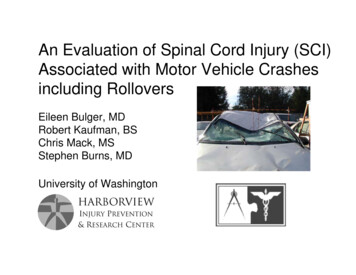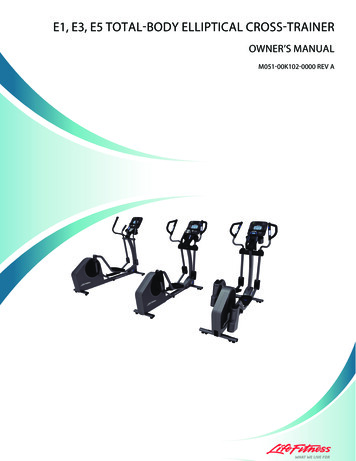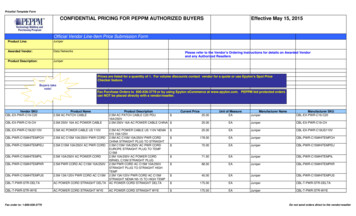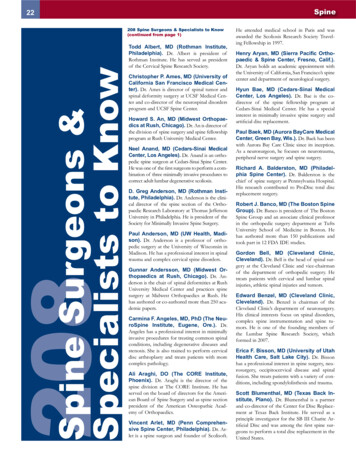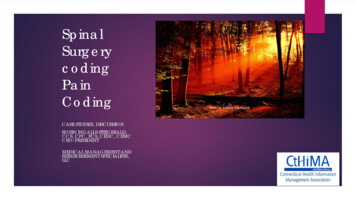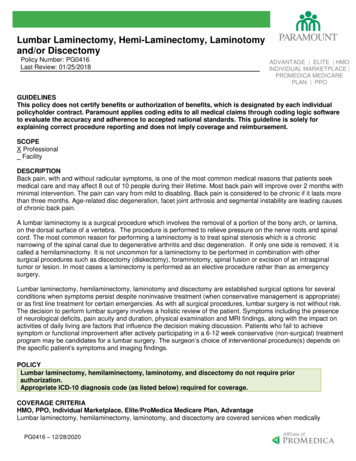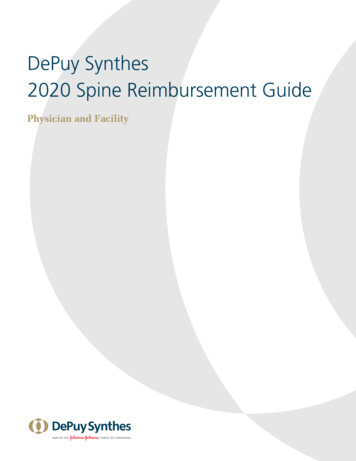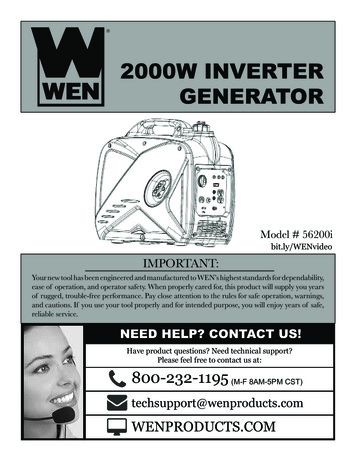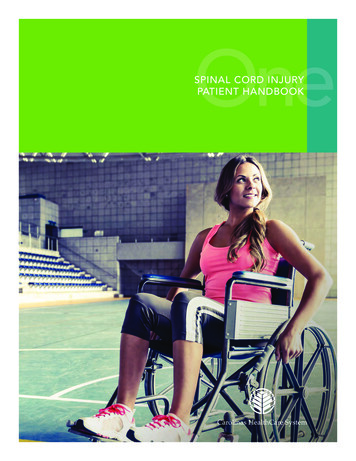
Transcription
OneSPINAL CORD INJURYPATIENT HANDBOOK
INTRODUCTION3SECTION I6Spinal Cord Injury Facts.7Spinal Cord Injury Research.11SECTION II12Autonomic Dysreflexia.13Bladder Management.18Bowel Management.40Medications.47Pain Management.55Nutrition.57Respiratory System.64Skin Care.75SECTION III85Adaptive Equipment.86Hazards and Safety Precautions.88Mobile Technology.93Upper and Lower Extremity Range of Motion.97Driving.110Recreation.128SECTION IV1 32Sexuality for Men.133Sexuality for Women.137Wellness and Resilience.145SECTION V1 59Financial and Community Resources.160Emergency Preparedness.178Home Modifications.186Ramp Specifications.190CAROL IN AS REH ABIL ITATION 2
INTRO DU C T IO NAs part of Carolinas HealthCare System, Carolinas Rehabilitation has been helpingpeople recover from injury and illness for more than 60 years. Our goal is to restoreeach person to a life that is as full and rewarding as possible – and to get that personback home as quickly as possible. That is our goal for you, too.This handbook is part of how we will help you reach that goal. It contains keyinformation that will help you understand your condition and tells you how to bestmanage the medical and physical challenges posed by your spinal cord injury. Thishandbook will help you continue your recovery once you leave the hospital. Theinformation in this handbook is specially selected for you. What you will read is basedupon the type of injury you had, where it was located in your spine, and your needsafter you have left the hospital.Year after year, an outside research company has found that we return more people totheir homes than most other rehabilitation hospitals in the South or anywhere else in thecountry. We attain these results by using an entire team of specialists to aid you duringyour recovery.Our team of specialists is called a “care team.” You and your family are the mostimportant members. Other members of your team include a physiatrist (a doctor whospecializes in rehabilitation medicine), nurses, physical therapist, occupational therapist,social worker, and urology nurse. There are also nutritionists, vocational counselors,vocational evaluators, a chaplain, educational specialists, and others who will work withyou if you need their services. Our team approach provides you with state-of-the-artcare that is matched to your special needs.CAROL IN AS REH ABIL ITATION 3
About Carolinas RehabilitationCarolinas Rehabilitation is a not-for-profit rehabilitation hospital that was foundedin 1950. It is a facility of Carolinas HealthCare System. With beds for 192 inpatientsdealing with spinal cord injuries, strokes, brain injuries, amputations, bone injuries,cancer, and more, Carolinas Rehabilitation is one of the largest comprehensiverehabilitation centers in the Southeast. We also provide a long list of outpatient servicesto help patients continue their recovery after they have left the hospital. You may bescheduled for some of these services after you leave the hospital.Carolinas Rehabilitation is also a training center for doctors specializing in rehabilitationmedicine as well as many other rehabilitation specialists. Our staff conductsrehabilitation research of many kinds and is continuously looking for better and moreeffective ways to help our patients.How to Use Your Spinal Cord Injury HandbookYour level of recovery will depend largely on how hard you work in your therapies andyour commitment to caring for yourself. To make sure you learn as much as possible,you should read this handbook carefully. The Handbook is designed to complementthe Spinal Cord Injury Education class series. The class series is a one-hour educationalclass offered every afternoon from 3 to 4 p.m. Each class is taught by a member of theinterdisciplinary team at Carolinas Rehabilitation. This team includes your occupationaland physical therapists, recreational therapists, nutritionist, wheelchair seating specialist,among many others. Your family is welcome to join these classes, and questions from allare encouraged. There are 10 classes total over a two week period, and the classes areinteractive so you can learn as much about your injury and recovery as possible. Bringyour Handbook to your therapy sessions and education classes to reinforce what yourtherapists are teaching, and review your Handbook to reinforce what you are learning.If something doesn’t make sense or if you run across medical terminology you don’tunderstand, ask about it. Your doctor, nurses, and therapists all understand howimportant it is that you learn everything you can. Questions are welcome. The quality ofyour future depends upon what you learn.CAROL IN AS REH ABIL ITATION 4
When you leave the hospital, it will be up to you to put everything you learned intopractice. Refer to it when you encounter new or difficult situations; it is like having atherapist with you.Finally, be sure to bring your handbook when you see your family doctor or visit theclinic. It can help your doctor understand more about how to handle your spinal cordinjury – and it is a handy place to add new information. You should also bring it whenyou return to Carolinas Rehabilitation for a clinic visit or outpatient therapy.A Final ThoughtWe want to wish you the best in your recovery, and we’re honored that you choseCarolinas Rehabilitation to help with your recovery. We will do everything we can tomake your stay here as successful as possible.CAROL IN AS REH ABIL ITATION 5
OneSECTION I
SECTION IS PINA L C O RD IN J U RY FA C T SSpinal Cord InjuriesA spinal cord injury is caused by trauma or disease to the spinal cord, most often resultingin paralysis (loss of strength), loss of sensation (feeling), and loss of control of bodilyfunctions.Currently, there are approximately 273,000 people in the United States who have spinalcord injury with 12,000 new injuries each year.Since 2010, the average age at injury is 42.6 years of age, with 80.7 percent of injuriesoccurring in men. There has also been an increase in the number of persons over 60 whohave spinal cord injuries.Causes of Spinal Cord Injuries Since 2010 36.5% – Vehicular accidents 28.5% - Falls 14.3% - Violence 9.0% - Sports 11.4% - Other/unknownParalysis, or loss of muscle strength, is the initial source of medical problems in personswith spinal cord injuries. Secondary medical problems include demineralization of bone,degeneration of the circulatory system, kidney and bladder dysfunction, pneumonia, andpressure sores.The average person who sustains a spinal cord injury can expect to be in rehab for threeto four weeks and spend 400,000 on medical care. 87.1 percent of all persons with SCIare discharged from rehab to their private home, usually returning to their residencebefore the injury. At the time of the injury, 57.1 percent of persons sustaining a SCI wereemployed. After one year, 11.8 percent of those with an SCI are employed, and after 10years, 34.9 percent are employed.(Information from the National Spinal Cord Injury Statistical Center, Birmingham, AL,www.nscisc.uab.edu/PublicDocuments/fact figures docs/Facts%202013.pdf)CAROL IN AS REH ABIL ITATION 7
SECTION IThe Normal Spinal CordYour brain is a lot like a computer for your body. It sends and receives messages from allparts of your body and handles all the complicated functions of your body. The spinal cordis the pathway traveled by the messages between the brain and other parts of your body.The spinal cord is made up of many nerve fibers. The spinal cord is surrounded andprotected by round bones called vertebrae. The vertebrae are stacked one on top ofanother like a chain, also called a backbone. The spinal nerves branch off the spinal cordbetween the vertebrae along the neck and back. These spinal nerves carry sensory andmotor information. Sensory refers to your ability to feel, and motor refers to your ability tomove. The sensory information goes from your arms and legs to your brain and the motorinformation goes from your brain to your arms and legs.Spinal CordSpinal NervesVertebraeCAROL IN AS REH ABIL ITATION 8
SECTION IThe Spinal Cord After an InjuryWith a spinal cord injury, all the nerves above the injury keep working like they alwayshave. Below the injury, feelings like hot, cold and pain can’t get to the brain, andmessages from the brain asking for movement can’t get to the muscles. The closer theinjury is to the brain the more of your body will have no feeling and the more muscleweakness you will experience. For example, someone with a T8 injury will typically havemore feeling and movement than someone with a C5 injury. In addition to affectingmovement and feeling, a spinal cord injury affects some body functions, such as bowel,bladder and sexual activities.Cervical VertebraeC1 – C7Thoracic VertebraeT1 – T12Lumbar VertebraeL1 – L5Sacral VertebraeCAROL IN AS REH ABIL ITATION 9
SECTION ITypes of Spinal Cord InjuryThe spinal cord damage can be severe where no information (feeling or movement)is able to pass the area of damage in the spinal cord. In a less severe case, somemessages are able to pass the damaged area. The amount and type of messagesthat can pass will depend on how many of the nerves are damaged in the spinal cord.Some people may have a lot of feeling, but little movement. Others may have somemovement and very little feeling. Spinal cord injuries will be different from one personto another because of the different nerves that are damaged. Sometimes the spinalcord is only bruised or swollen. With time, the nerves may heal and begin to workagain. We do not have any tests at this time to predict which nerves (if any) will begin towork after spinal cord injury.We use a scale called ASIA (American Spinal Injury Association) Impairment Scale todetermine the degree of damage to the spinal cord. Your doctor and therapists will testyou to see which areas of your body have normal or impaired feeling and normal orimpaired movement. This helps to determine how severe the damage was to the spinalcord and will be continually monitored for improvement.ASIA Impairment Scale ASIA A: means there is no feeling or movement below the damaged area in thespinal cord ASIA B: feeling, but no muscle strength, is present below the damaged area ASIA C: weak muscle strength is present below the damaged area ASIA D: strong muscle function is present below the damaged area ASIA E: feeling and muscle function is normal below the damaged area of the spinal cordCAROL IN AS REH ABIL ITATION 10
SECTION IS PINA L C O RD IN J U RY R E S E A R C HThe physicians, nurses and clinicians at Carolinas HealthCare System are activelyinvolved in several research studies related to spinal cord injury treatment. Weencourage you to have your name added to our Spinal Cord Registry so we can contactyou following your discharge if we become aware of a study or program we feel youwould benefit from. Your nurse or therapist can contact our Research Department if youare interested.Research studies are currently underway in many areas including: Medication Management Heart Disease Prevention and Management Pressure Ulcer Management Hypothermia Functional Electrical Stimulation Cellular Therapy Depression Fertility Pain Spasticity Bowel and Bladder Respiratory (Ventilator weaning)Before participating in any clinical trial it is important to educate yourself. You shoulddiscuss whether a study is appropriate for you with your physician. We also recommendyou read the following: Experimental Treatments for Spinal Cord Injury: What You Should Know If You AreConsidering Participation In A Clinical Trial 1-800-539-7309 www.icord.org/ICCP/Experimental treatment for SCI-full.pdfYou can get more information on current clinical trials from the following resources: Chapter 4 Paralysis Resource eguide/ ClinicalTrials.gov RehabTrials.org 973-243-6806 Center Watch.com 617-948-5100 Spinal Cord Injury Information Network: Research Studieswww.spinalcord.uab.edu/show.sp?durki 21777CAROL IN AS REH ABIL ITATION 11
OneSECTION II
Section IIAU TONO M IC DY SR E F L E X I AAutonomic dysreflexia (ot-toe-NAWM-ick dis-re-flex-ee-ah) is an emergency situationand a complication that can be seen in almost anyone with a spinal cord injury abovethe thoracic level 6. It is important to be able to recognize this complication and knowwhat causes it and how to treat it, as it can be life threatening.What May I See And Feel?Symptoms(you may not have all of them)Why does this happen?Severe pounding headacheHigh blood pressureSeeing spots in front of your eyesHigh blood pressureBlurred visionHigh blood pressureSlow heart rateBrain’s response to high blood pressureGoosebumps above level of SCIBody’s exaggerated response to continuousdilation of blood vesselsSweating above level of SCIBody’s exaggerated response to continuousdilation of blood vesselsFlushing of skin above level of SCIBody’s exaggerated response to continuousdilation of blood vesselsNasal stuffinessBody’s exaggerated response to continuousdilation of blood vesselsIMPORTANT: Uncontrolled high blood pressure is the dangerous part of autonomicdysreflexia, for it may be high enough to cause a stroke.C AR OL IN AS R E H AB I L ITATION 13
Section IIWhat to Do if You Have These Symptoms1. Sit up if you are lying down. This will decrease your blood pressure.2. F ind and remove the cause. Autonomic dysreflexia usually will not go away untilthe cause of the problem has been corrected. C heck for bladder problems first. If you do not have a catheter in place,catheterize yourself. Empty your bladder slowly by lifting the draining end of yourcatheter. If you empty your bladder too fast, you may cause it to go into spasm,which can cause your blood pressure to go up again. C heck for bowel problems next. If your bladder is not the cause of the high bloodpressure, check your bowel for stool. If there is stool in your rectum, you will needto remove it manually. Before removing the stool, you should apply numbingmedicine to the anus and then wait five minutes for the medicine to work. This willprevent further stimulation to the area, which can cause your blood pressure to goup even more. If overheated, place a cool damp cloth on your head, at your groin and armpits,and get to a cool place. Check for skin problems. If neither your bowel nor your bladder seems to be thecause, remove your clothing and look for cuts, bruises, or ulcers on your body.3. Apply Nitroglycerin ointment to your skin above the level of injury, or takenifedipine if your physician has given you this medication. This will lower yourblood pressure while you are trying to find out why this has happened. Only certainpatients who get autonomic dysreflexia frequently will be given this medication.4. GET HELP if you can’t find the cause. Call or go to the nearest hospital.Autonomic dysreflexia is an unusual problem, and not all health providers will knowhow to treat it.A physician should be notified immediately, as this is a medical emergency.C AR OL IN AS R E H AB I L ITATION 14
Section IIWhat Causes It?Autonomic dysreflexia is generally broughton by something that would have signaledpain or discomfort before your injury. Somepossible causes are listed below, with themost common first.1. A full or distended bladder (frequentlycaused by a plugged catheter)2. Stool impaction (severe constipation)3. Infections (bladder, etc.)4. Medical tests and procedures5. Pressure sores6. Traumatic pain (severe cuts or brokenbones)Non-spinal cordpathway Tells the brainwhat bloodvessels aredoing to dilate7. Hot and cold temperaturesSpinal cordpathway Tells bloodvesselsto dilate8. Sunburn9. Tight clothes10. Pressure on the testicles or penis11. Severe menstrual cramps, labor(uterine contractions)12. Stomach ulcersPain in hipBlood vesselsconstrict (reflex)13. Certain drugsHow Does It Happen?The Body’s Response to Pain: Before SCI1. Blood vessels constrict by reflex activity and raise your blood pressure.2. Nerves send messages up to the brain through your spinal cord, so you actuallyfeel the pain.3. Other nerves send messages up to the brain through automatic pathways otherthan the spinal cord to tell the brain what is happening to your blood vessels andblood pressure.4. The brain then sends a message down through the spinal cord to dilate (open up)your blood vessels, which will lower your blood pressure again.C AR OL IN AS R E H AB I L ITATION 15
Section IIThe Body’s Response to Pain: After SCI1. B lood vessels constrict by reflexactivity and raise your blood pressure.2. You will most likely not feel the pain,because the pain messages cannotpass through the injured spinal cord.3. O ther nerves send messages up tothe brain through automatic pathwaysother than the spinal cord to tell thebrain what is happening to your bloodvessels and blood pressure.4. If your injury is at or above T6 level,your brain cannot get the dilationmessage back down to the bloodvessels below your injury. The reasonfor this is that the area from T6 to T10of the spinal cord sends messagesto most of the blood vessels in yourbody. Your blood pressure stays highbecause the shut-off valve to loweryour blood pressure does not work.IMPORTANT: Autonomic dysreflexia is likea vicious cycle that cannot be broken untilyou find the cause and remove it. This canbe a life threatening emergency.Non-spinal cordpathway Tells the brainwhat bloodvessels aredoingSpinal cordpathway Tells the bloodvessels todilate, but themessage can’tget past thelevel of injuryLevel of spinalcord InjuryPain in hipBlood vesselsconstrict (reflex)Becomes moreintenseC AR OL IN AS R E H AB I L ITATION 16
Section IICan Autonomic Dysreflexia Be Prevented?You can prevent these symptoms in many cases, but not always.Since the most common causes of autonomic dysreflexia are a full or distended(bloated) bladder and impactions of the bowel, you can prevent this from happening bymaking sure:1. Your bladder is emptied routinely.2. Your catheter is draining well.3. You have routine bowel movements.If you have this problem more frequently, your doctors may put you on medication toprevent it.REMEMBER: If you do develop autonomic dysreflexia, you will soon learn what causesit for you. Then you will be able to treat it quickly and effectively.CARRY YOUR CARD! If you are at risk for autonomic dysreflexia, your nurse or therapistwill give you a card. The card explains what autonomic dysreflexia is and how to treatit. Carry this in your wallet or purse at all times. Let people know you have this card anduse it with medical staff to instruct them in Emergency Care. It may save your life!C AR OL IN AS R E H AB I L ITATION 17
Section IIBLAD D E R M A N A G E M ENTBefore your spinal cord injury, you probably did not pay much attention to your urinarysystem because urinating occurred so automatically. During the first few months afterinjury, you and certain members of the spinal cord injury team will be spending whatseems like a great deal of time establishing and managing your bladder program.Eventually, your bladder program will become quick and routine.In this chapter, we will explain:1. The urinary system.2. How the urinary system has changed since your SCI.3. The reasons for bladder management.4. How to recognize and avoid problems.The Urinary SystemThe urinary system consists of the kidneys, the ureters (YURR-ut-airs), the bladder, andthe urethra (yur-EETH-rah). Refer to the upcoming sections on male or female urinarysystems for diagrams.C AR OL IN AS R E H AB I L ITATION 18
Section IIHow Does My Urinary System Work?The kidneys remove wastes and excess water from your blood stream and processthem into urine. The urine then flows down small tubes called ureters to your bladder.The bladder is a muscular sac that stretches to hold urine until the body is ready tovoid (urinate). When voiding occurs, the bladder contracts and the sphincter (which is acircular muscle acting as a gate) opens. Urine then passes through the sphincter into atube called the urethra and you urinate.Kidney: Toxic wastes and excess water are filtered through the kidneys and processedinto urine.Ureter: Urine passes from the kidneys to the bladder through small tubes called ureters.Bladder: The bladder is the body’s storage tank for urine. It is a hollow sack made ofthick muscle which stretches to fill and contracts (squeezes) to empty.External Urethral Sphincter: The sphincters are muscles that control the outflow of urine.Urethra: Urine passess from the bladder to outside of your body through the urethra.Normal UrinationUrination is due to a finely balanced coordination of bladder and sphincter muscles.This coordination involves both voluntary and involuntary (or automatic) control by thenervous system. When the bladder becomes full, messages are sent to the lower levelof the spinal cord in your pelvis. Messages are then sent through your spinal cord toyour brain to let you know that your bladder is full. At this time you can decide to eitherurinate or hold the urine. This is the part under voluntary control. If you want to urinate,the brain will send messages down the spinal cord and back to the urinary system.The involuntary part involves the opening of the sphincter muscle, and bladder musclecontraction. This allows your bladder to keep urine pressures low.C AR OL IN AS R E H AB I L ITATION 19
Section IIHow Is My Bladder Function Changed By Spinal Cord Injury?Nerve impulses from the bladder can no longer get to and from the brain to let yousense that your bladder is full or to let you void. There are two general kinds of bladderdysfunction that can occur depending on your level of injury. Because there can beindividual variations, you will probably have some tests to diagnose your particularbladder type.These types of bladder dysfunctions are described next. U pper motor neuron bladder (reflex or spastic bladder)In this condition, the bladder tends to hold smaller volumes of urine than beforeSCI. Just like your other muscles may have spasms and contract on their own, socan the bladder muscle. The result is that you may have frequent, small urinationswithout control. This bladder type is common in most spinal cord injuries abovethe sacral level. This type of urination generally happens with elevated bladderpressures and is a significant cause of urinary tract infections (UTIs). Lower motor neuron bladder (flaccid bladder)In this condition, the bladder muscle has lost its ability to contract and can be easilystretched. Therefore, large volumes of urine can be held by the bladder at lowpressure. Because the muscle cannot contract, urine leaves the bladder only when itis overfilled. The urine “spills over” out of your bladder into your urethra like a glassthat is too full of water. The bladder type is common when SCI affects the sacrallevel of the cord (cauda equina injuries).C AR OL IN AS R E H AB I L ITATION 20
Section IIWhat Tests Are Done to Check My Bladder Function?There are a number of tests that can evaluate the structure and function of the urinarysystem. You may have one or several of them.What is an ultrasound?An ultrasound, or sound waves (like sonar) are bounced off tissue surfaces, and anelectronic picture is produced on a screen. Variations in the color of the image candetail the structures or anatomy and thus define problems.What is an intravenous pyelogram (IVP)?An IVP is done by injecting dye containing iodine into a vein. This is excreted by thekidneys and shows up in X-ray. This X-ray will show the size, shape, and working orderof the kidneys, ureters, and bladder.PLEASE NOTE: if you have ever had an allergic reaction to IVP dye, be sure to tellyour physician.Your bowel needs to be empty for this test, so do a good bowel program the eveningbefore or the morning of the test. You may also have to refrain from eating and drinking thenight before the test. The nursing staff will let you know if other preparation is necessary.What is a renal scan?The purpose of a renal (REE-null) scan is to assess the function and the blood supply ofthe kidneys. It is done by injecting a radioactive substance into a vein before X-rays aretaken of the kidneys. The amount of radioactivity is extremely low.C AR OL IN AS R E H AB I L ITATION 21
Section IIWhat is a cystourethrogram (siss-toh-yurr-EETH-roh-gram)?This is also called a cystogram, and is another X-ray study which shows the size andshape of the bladder. Dye is inserted through a catheter into the bladder, and thisshows up on an X-ray. Among other things, this test shows if urine moves backwardthrough the system from the bladder up to the kidneys. This condition is called reflux.Reflux is due to excess pressure in the bladder. This is one cause of kidney damage andneeds to be detected early.What is urodynamics (yurr-oh-die-NAMM-icks)?A urodynamics evaluation consists of a series of studies that provide information aboutthe mechanics of voiding. Tests which may be part of this urodynamics evaluationinclude a cystometrogram, a study of urine flow, a study of urethral pressures, and yourresponse to medication that can affect voiding. These tests also give information onsphincter activity and urethral pressures, during bladder filling and emptying. This aidsin planning the best bladder management program for you.What is a cystometrogram (siss-toh-METT-roh-gram) (CMG)?A CMG shows how your bladder reacts when it is filled with either carbon dioxide (CO2)or water. This mimics the way it would usually react when filled with urine. A catheter isinserted for this test. A CMG helps determine if you have a UMN (Upper Motor Neuron)or LMN (Lower Motor Neuron) bladder type. The amount of pressure which builds inyour bladder will also be measured by this test.What is a cystoscopy (siss-TOSS-koh-pee)?Cystoscopy involves the urologist looking at the inside of your urethra and bladderthrough a lighted, hollow, specialized catheter inserted through the urethra. This is usedin diagnosing problems occurring inside the bladder.What other laboratory tests are done?There are a number of tests evaluating the blood and urine that show how your urinarysystem is functioning: C reatinine (kree-AT-en-een) clearance: This test involves collecting all of your urinefor a 24-hour period. It is an important indicator of kidney function. U rine cultures: In this test, a sterile urine specimen is sent to the laboratory to lookfor bacteria. When a sensitivity is also ordered, specific antibiotics that kill thesebacteria can be determined. U rinalysis: Urine is analyzed for a number of different chemical and cellular products.C AR OL IN AS R E H AB I L ITATION 22
Section IIHow Do I Empty My Bladder After SCI?If you have an incomplete injury, you may eventually regain all or some voluntary controlof your bladder.If you have a complete injury, one or a combination of the following bladder emptyingtechniques will become part of your bladder management program.CatheterizationA catheter is a small rubber or plastic tube inserted into the bladder to drain urine. If thisis done several times a day, we refer to the process as an intermittent catheterizationprogram, or ICP. ICP is generally done by the nursing staff on all SCI persons in the firststages after injury. It may also be continued at home.A catheter that is left in the bladder is an indwelling catheter. It is often referred tosimply as a “foley.”Another less common type of
and physical therapists, recreational therapists, nutritionist, wheelchair seating specialist, among many others. Your family is welcome to join these classes, and questions from all are encouraged. There are 10 classes total over a two week period, and the classes are interactive so you can

